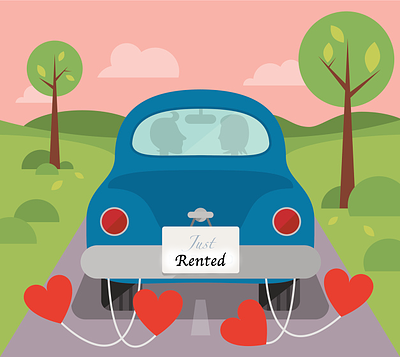Why Cohabitation is Like “Rent to Own”
3 min read
Date Published: 09/14/2013
Last Updated: 06/11/2018
National Fatherhood Initiative Blog / Latest Articles
3 min read
The following is a post from Christopher A. Brown, Executive Vice President of National Fatherhood Initiative (NFI). Interested in blogging for us? Read our guest blog guidelines.
Cohabitation has risen rapidly in the past 40-50 years. In 1965, only 11 percent of couples lived together without being married. By 2010, that proportion had vaulted to 60 percent. Cohabitation is now the pathway of choice to marriage with about 2/3 of women reporting that they lived with their partners first before marrying them. Moreover, more than half of cohabitating couples get married within three years. For those of you who hope for a return to the time when even a majority of couples married first and then moved in together, I’m sorry to say that ship has sailed and sunk.

There are a myriad reasons couples choose to live together before marrying, or simply instead of marrying at all. For those couples considering marriage, one of the primary reasons is that they want to “test the water.” A term that has come into vogue among scholars who study cohabitation is “sliding before deciding.” (I prefer “rent to own,” but more on that later.) If it doesn’t work out, these couples reason, no harm, no foul.
But what happens after these couples move in together? Are they more likely to like the water and jump in with both feet? A recent study by the Centers for Disease Control and Prevention (CDC) reveals that a good chunk of them are. According to the CDC, 40 percent of cohabiting couples between 2006 and 2010 decided to tie the knot with another 32 percent deciding to stay together ostensibly with the potential for marriage. (The rest of the couples split up.)
While sliding before deciding accurately describes the process that leads to a decision to marry among cohabiters, I prefer “rent to own” because it also considers the possible outcomes—marriage, staying together, or splitting up—and the impact of each one. When a couple decides to marry, it’s a decision to own—the couple “buys” marriage. When a couple decides to stay together, it’s a decision to extend the rental agreement. When a couple decides to split up, it’s a decision to either discard the rental or exchange it for another one.
Another reason I like this rather crass analogy is that it facilitates moving beyond the decision to compare the first two outcomes. What happens after someone decides to own (marry) or continue the rental agreement (cohabit)? This is where it gets interesting and illuminating.
The most common way in which scholars have looked at the impact of these outcomes is whether cohabitation is more likely to lead to divorce than when couples don’t live together before marriage. While the impact on divorce is a very important discussion, what’s gained less attention is the impact of rent-to-own decisions on the quality of relationships between cohabiting and married couples. Especially in today’s society where marriage seems to be more about the couple’s satisfaction than any other factor (e.g. raising healthy children), it’s critical to examine the impact of these outcomes on how couples see the quality of their relationships which, after all, has a lot to say about whether couples ultimately stay together.
Married couples consistently report that they are happier/more satisfied with their relationships than are cohabiting couples. Moreover, the proportion of cohabiting couples who are satisfied with their relationships has declined over time even as their numbers have increased. Not so for married couples whose satisfaction level has remained stable. This outcome doesn’t bode well for the couples who renew their rental agreements.
What leads to these different levels of satisfaction? Scholars didn’t really know until a recent study by some smart folks at Texas Tech University shed some light. These scholars focused on the impact that “disillusionment” has on relationships. Disillusionment theory (yes, it’s a theory) suggests that when people date, they engage in a dance to impress each other. (Think of the male peacock and his plume.) Once married, they aren’t as motivated to impress each other. The idealized images they held of each other while they dated start to fade as does attraction, romance, affection, etc. Disillusionment leads to divorce in some couples. Think of disillusionment as depreciation. Just as something you own depreciates in value over time, so too can your view of your partner and the relationship in general.
Until this study, scholars had only looked at the effects of disillusionment among married couples. The smart folks at Tech looked at it for the first time among cohabiting couples, compared their levels of disillusionment to those found in married couples, and examined its impact on perceived break-up (i.e. divorce among married couples and splitting up among cohabiting couples). They found that cohabiting couples were more disillusioned than married couples. Furthermore, disillusionment was a greater predictor of perceived break-up among cohabiting couples than it was among married couples.
While the perception of a break-up doesn’t necessarily mean that a couple will break up, disillusionment helps explain why married couples are, quite simply, more satisfied with their relationships than cohabiting couples. When a couple rents to own and renews their rental agreements, the partners’ view of each other and the relationship depreciates to a greater degree than does a married couple’s. It’s likely that once married, the commitment partners have to each other and their relationship has a protective effect on depreciation. Married partners have a higher ownership stake and place a higher value on each other and their relationship.
Date Published: 09/14/2013
Last Updated: 06/11/2018
Download the ebook to learn how to create fatherhood initiatives that engage every sector of community life.

Train Your Staff
Fatherhood Programs
Fatherhood Data
© 2026 National Fatherhood Initiative®. All rights reserved.